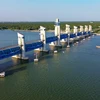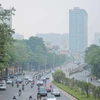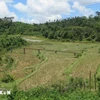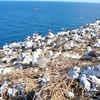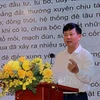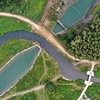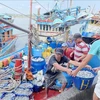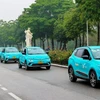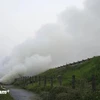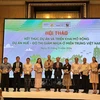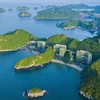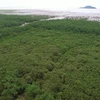Hanoi authorities plan to encourage the growth of water plants in the city's lakes to offset chronic pollution.
The biological approach to purifying the capital's lakes has received a positive response from the municipal People's Committee, said Professor Duong Duc Tien, director of the Biology Technology for Life Centre.
Tien and his team plan to build organic filter houses on the sides of the city's lakes. The proposal will be submitted to city leaders by the end of the year.
Meanwhile, bamboo rafts have been tested on a number of Hanoi 's most polluted lakes, such as Thanh Cong, Giam and Thien Quang, as a cost-effective alternative to expensive chemicals.
Mai Dinh Yen, a biology professor at Hanoi National University , said official attitudes to lake pollution have changed.
"The acceptance of the idea in itself demonstrates local leaders' awareness of the problem and how best to tackle it. People used to think water plants tarnished the appearance of lakes," Yen said.
Aquatic plants such as reeds, hyacinth, evergreens and lettuce have very large roots, which can absorb organic substances and heavy metals dissolved in the water, Tien said.
Yen said the organic approach to tackling water pollution has been used throughout the world since the 1970s.
"That goes for developed countries such as Japan and Germany ," he said.
Dr Tang Thi Chinh, head of the Environment Micro-organism Department at the Environment Technology Institute, also supported the use of aquatic plants to purify the city's lakes.
She said most of the lakes in Hanoi and across the country were polluted by an excessive amounts of nitrates and phosphorus, which plants require to grow.
She also said the organic approach is also far cheaper than using expensive chemicals.
"Aquatic plants are in general very cheap. Some of them are wild and very popular in the countryside where water is polluted," Yen said.
"The Government can only afford to chemically treat two or three lakes. That money could be far more effectively spent on the biological method," Tien said.
He said it costs 2,500 VND to purify 1 cubic metre of lake water using a chemical formula developed by Hanoi scientists. It would therefore cost 250 million VND (12,500 USD) to purify a relatively small 100,000 cubic metre lake.
Both Tien and Yen also said that chemical treatment could harm biological ecosystems, as could dredge.
However, experts warn that aquatic plants, such as hyacinth, needed to be closely monitored so that they didn't overwhelm a lake and cut off sunlight to other water plants.
Yen also said that different plants were better suited to combating certain types of pollution.
"There's an urgent need for more scientific research on this," he said.
They also said that public awareness about the need to keep the city's lakes clean needed to be improved.
"If people throw litter or discharge sewage into lakes, there's no way to keep the water free of pollution," said Le Ha Vinh, a member of a residential association in Dong Da district's Nguyen Phuc Lai street, close to Hoang Cau Lake.
Some 95 percent of the 120 lakes in central Hanoi are polluted, according to the Centre for Environment and Community Research.
Most of the lakes have a BOD5 (Five-day Biochemical Oxygen Demand) rating higher than the 15 milligrams per litre – the maximum considered safe.
Van Chuong, Giam, Linh Quang, Ngoc Khanh and Truc Bach have a BOD5 rating of 40-50 miligrammes per litre, due primarily to untreated sewage./.
The biological approach to purifying the capital's lakes has received a positive response from the municipal People's Committee, said Professor Duong Duc Tien, director of the Biology Technology for Life Centre.
Tien and his team plan to build organic filter houses on the sides of the city's lakes. The proposal will be submitted to city leaders by the end of the year.
Meanwhile, bamboo rafts have been tested on a number of Hanoi 's most polluted lakes, such as Thanh Cong, Giam and Thien Quang, as a cost-effective alternative to expensive chemicals.
Mai Dinh Yen, a biology professor at Hanoi National University , said official attitudes to lake pollution have changed.
"The acceptance of the idea in itself demonstrates local leaders' awareness of the problem and how best to tackle it. People used to think water plants tarnished the appearance of lakes," Yen said.
Aquatic plants such as reeds, hyacinth, evergreens and lettuce have very large roots, which can absorb organic substances and heavy metals dissolved in the water, Tien said.
Yen said the organic approach to tackling water pollution has been used throughout the world since the 1970s.
"That goes for developed countries such as Japan and Germany ," he said.
Dr Tang Thi Chinh, head of the Environment Micro-organism Department at the Environment Technology Institute, also supported the use of aquatic plants to purify the city's lakes.
She said most of the lakes in Hanoi and across the country were polluted by an excessive amounts of nitrates and phosphorus, which plants require to grow.
She also said the organic approach is also far cheaper than using expensive chemicals.
"Aquatic plants are in general very cheap. Some of them are wild and very popular in the countryside where water is polluted," Yen said.
"The Government can only afford to chemically treat two or three lakes. That money could be far more effectively spent on the biological method," Tien said.
He said it costs 2,500 VND to purify 1 cubic metre of lake water using a chemical formula developed by Hanoi scientists. It would therefore cost 250 million VND (12,500 USD) to purify a relatively small 100,000 cubic metre lake.
Both Tien and Yen also said that chemical treatment could harm biological ecosystems, as could dredge.
However, experts warn that aquatic plants, such as hyacinth, needed to be closely monitored so that they didn't overwhelm a lake and cut off sunlight to other water plants.
Yen also said that different plants were better suited to combating certain types of pollution.
"There's an urgent need for more scientific research on this," he said.
They also said that public awareness about the need to keep the city's lakes clean needed to be improved.
"If people throw litter or discharge sewage into lakes, there's no way to keep the water free of pollution," said Le Ha Vinh, a member of a residential association in Dong Da district's Nguyen Phuc Lai street, close to Hoang Cau Lake.
Some 95 percent of the 120 lakes in central Hanoi are polluted, according to the Centre for Environment and Community Research.
Most of the lakes have a BOD5 (Five-day Biochemical Oxygen Demand) rating higher than the 15 milligrams per litre – the maximum considered safe.
Van Chuong, Giam, Linh Quang, Ngoc Khanh and Truc Bach have a BOD5 rating of 40-50 miligrammes per litre, due primarily to untreated sewage./.

